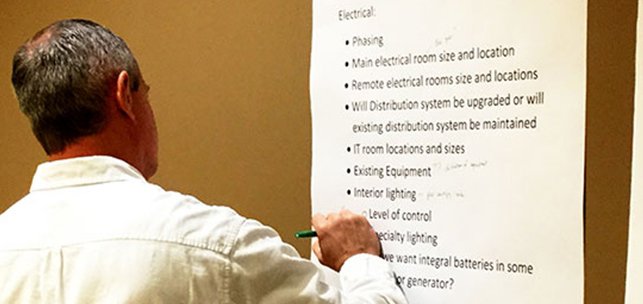How can you get the most efficiency out of your building while improving employee well-being? Here are a few ways to start.
EASY
- Let the sun shine in. Install additional windows to let daylight filter through your building and cut back on lighting costs. New glazing treatments and insulated panes ensure a tight seal so you don’t lose air to drafts.
- Make over your break room. Upgrade to Energy Star appliances. Consider a compact or drawer-style dishwasher and stock up on flatware and dishes as you pull back on the amount of paper, plastic, and Styrofoam you order.
- Give people reasons to walk around and move. Create a seasonal outdoor patio for breaks and small-group meetings. Organize a lunchtime walk once a week. If you have a multistory building with an elevator, make your stairwells more attractive so people use them more often.
- Change air filters regularly. Filters loaded with dust create more resistance. This increases energy use, causing wear and tear on your building system as it works to push air through and maintain a consistent temperature.
- Switch to LED lighting. LED lighting reduces glare along with the flicker and hum sometimes seen with fluorescent bulbs. It also stays cool to the touch (unlike traditional incandescent bulbs), is suitable for a wide range of rooms and outdoor spaces, and consumes substantially less electricity.
- Set a temperature range. Your heating and cooling systems will cycle on more frequently if you choose a specific degree level. Instead, select a temperature range that will be comfortable for your building’s inhabitants. Adjust as needed so space heaters and fans don’t pop up at individual work stations, fighting against the building’s thermostat.
MODERATE
- Schedule a retro-commissioning appointment. Mechanical, electrical, and technology engineers can observe and test your building systems to see if HVAC, plumbing, wiring, and cabling are performing as intended. They’ll make recommendations based on what they learn.
- Update your system controls. Darrell Bren, an Associate and Senior Electrical Engineer at TSP, Inc., suggests automating lighting and mechanical systems with timers that “remember” for you. An electronic thermostat can maintain separate ideal temperature ranges for open and closed hours, for example. User controls can be set to allow employees to change the temperature within a predetermined range but not bump past a stated low or high. An electrical counterpart can turn off indoor and parking-lot lights that aren’t needed after the business day is done.
- Add occupancy sensors. “We’re designing occupancy sensors in new and remodeled buildings. These sensors automatically turn off lights when the space is not occupied,” says Bren, who also is a LEED Accredited Professional. “These work especially well in storage, meeting, or breakout rooms. People enter and leave throughout the day, but in reality, these areas are empty a major of the time.”
- Balance indoor and outdoor airflow. It’s important to bring in the right amount of outdoor air. Too little outdoor air may cause poor quality of indoor air. Too much, and you’re wasting energy to heat and pre-cool large volumes you don’t need for proper conditioning and airflow. Install or update sensors and dampers to regulate volume and help maintain temperatures.
- Add a variable-frequency drive to your system’s motors. Older HVAC systems move the same amount of air and water all day long and year round. Variable-frequency drives reduce the speed of motors, allowing systems to move only the amount of air or water that’s needed. Slowing a motor down by half reduces the system’s energy use by 88%—producing a huge energy savings in our varied climate.

